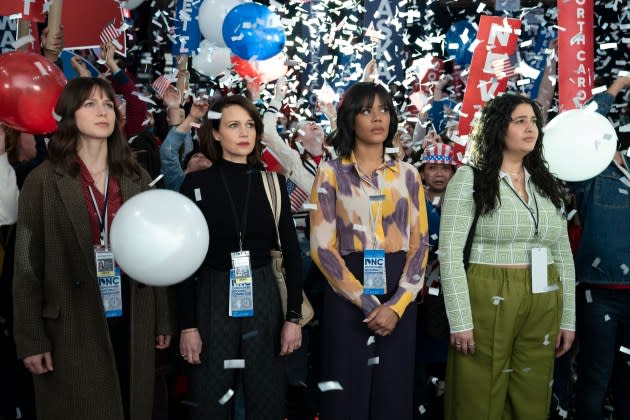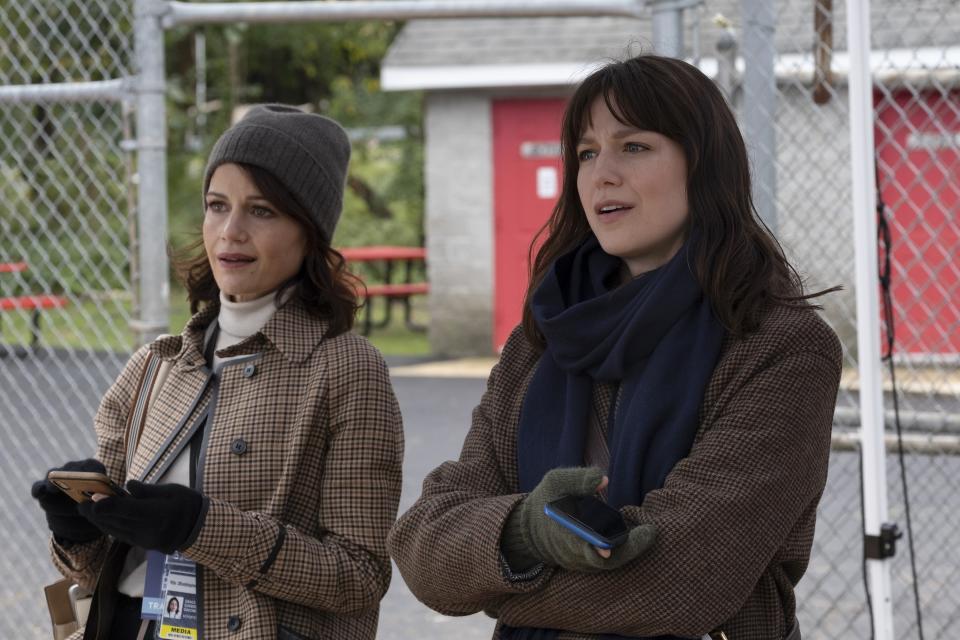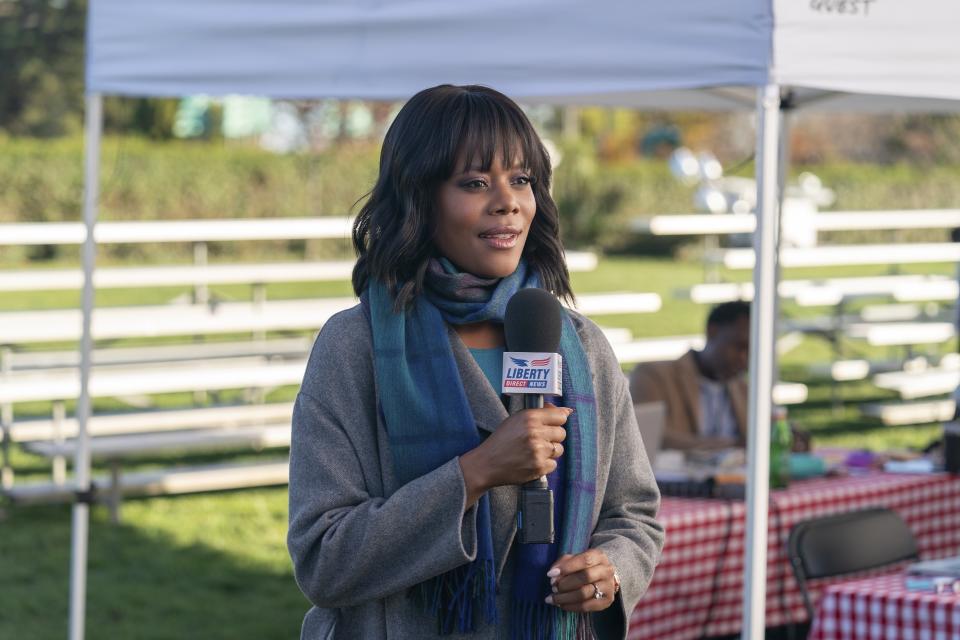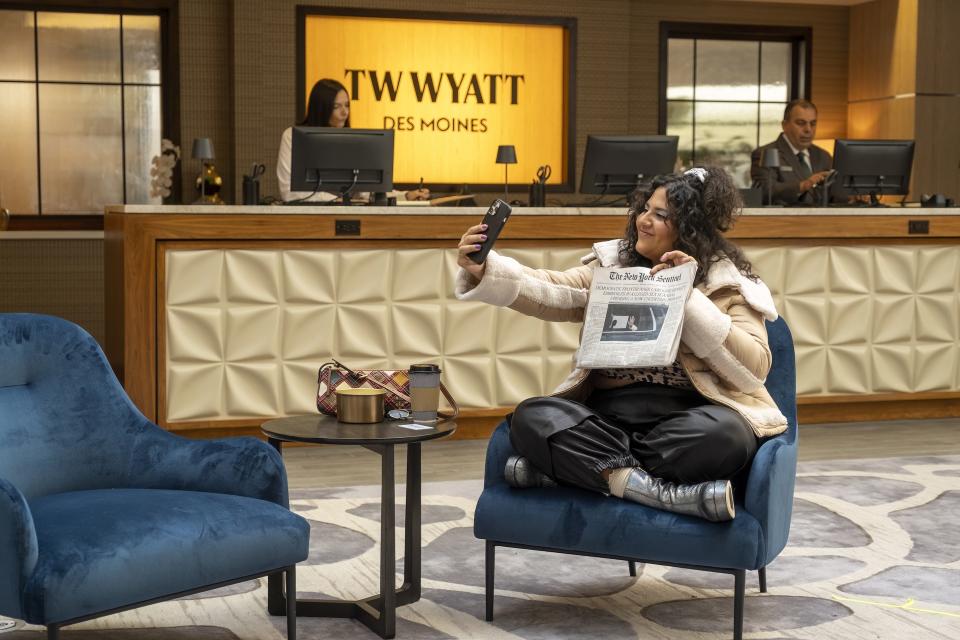‘The Girls On The Bus’ Team Amy Chozick and Julie Plec On Creating Female Agency And The Complexity Of Mapping Out A Fun, Balanced Political Landscape
- Oops!Something went wrong.Please try again later.
- Oops!Something went wrong.Please try again later.
- Oops!Something went wrong.Please try again later.

Max’s political dramedy The Girls on the Bus is less about the commonly depicted cutthroat world of politics and more about the unique friendships that can be cultivated in such a high-pressure environment along the way.
The series, based on journalist Amy Chozick’s 2018 memoir Chasing Hillary, follows four female journalists — played by Melissa Benoist, Carla Gugino, Christina Elmore and Natasha Behnam— as they cover the successes and scandals of the presidential primary while on the campaign trail. Though each of the women come from different backgrounds and harbors different opinions from each other on controversial topics and are sometimes in direct competition with each other, they nevertheless find themselves foraging a bond during their travels.
More from Deadline
Pete Distad Named CEO Of Disney, Fox & Warner Bros. Discovery's Sports Streaming Service
2024 NCAA Basketball Deals, Special Programming Offered By Max
The title of the series, which comes from a singular chapter in Chozick’s book, is a nod to Timothy Crouse’s 1973 book, The Boys on the Bus, which detailed life on the road for journalists covering the contentious 1972 U.S. Presidential Election between Richard Nixon and George McGovern.
Here, Chozick and Julie Plec, who serve as the co-creators and executive producers, speak to Deadline about reliving a fictional version of the 2016 election, finding their leading ladies, the importance of journalistic integrity and the fun challenges of creating the series.
DEADLINE: What do you both remember about Hillary Clinton’s presidential run? And when sitting down to make the show, what was the most important thing to capture first and foremost?
AMY CHOZICK: When writing the show, we knew we wanted to live in a fictional world, which was very fun. So, no Hillary, no Trump. There are certainly a lot of themes from my book that I experienced while covering Hillary, as well as a lot of the details and rawness of emotions that Julie and I first felt when we sat down to dream up these characters for the show. But we created a totally fictional world that didn’t feel like we were reliving 2016.
JULIE PLEC: Which was hard because the world that we live in is so specific that even giving life to and dreaming up a character like Kimberlyn, for example, who is a very savvy, very smart, very compassionate, very centered, very intelligent Black conservative. We had to do a lot of research just to say, ‘OK, well, what kind of political landscape would support a character like this and make it make sense?’ So, in this current landscape, it’s really difficult to understand where people are coming from in certain ways. It was a fun exercise to dream of a world in which the circus of politics was not as extreme as it is in our day-to-day existence.
DEADLINE: When did you two start to work on the project and how did Greg Berlanti factor in?
CHOZICK: Warner Brothers initially optioned my book, and then Greg Berlanti became a producer. It was his idea that he said the book lives here in this chapter called The Girls on the Bus, about how women had sort of taken over this purview that used to be all male, swashbuckling male reporters and the friendships that formed. And then he thankfully connected me to his old friend, Julie Plec. We met around 2018, 2019?
PLEC: Yeah, I think it was 2018, when you and I met. We were in New York when I met you for the first time, but Greg had called me and just said, “I have your next project.” That was it. He was very excited about it, and I said, “OK,” because that’s what you say when Greg Berlanti calls. Then I read the book and was really excited by the world. Everything I try to do is grounded in themes of found family, which is really what the show is about.
DEADLINE: You’re primarily a genre writer, and you have things like Kyle XY, Vampire Diaries and Riverdale on your resume. Was there a challenge in coming from fantasy to something more realistic?
PLEC: The challenge that always exists when you’re trying to write something without a thriller hook or a genre hook is just finding the balance of how much story you need to make the show feel propulsive in its own way. I always say that genre is a great framework for telling very simple coming-of-age or young love or family dramas. So, for me, this was an opportunity to finally write something that didn’t need to have a huge launch point, a big monster of the week, those kinds of things that you do in the genre space or rely on any kind of magical realism. And yet, when all is said and done, we found small ways to build the foundation of the show story-wise, around a small mystery and a little bit of realism in the form of Hunter S. Thompson. So, we got a little bit of magical realism in there.

DEADLINE: Having Hunter S. Thompson as Sadie’s conscience is a great choice. The way they bounce off each other is so funny. How did this idea of having this journalistic spirit guide around her come about?
CHOZICK: I feel like writers often have a loud inner voice. So, I thought Sadie would have a loud inner voice, which we initially thought would be really fun. We conceived many different ghosts, but then it just became Hunter. I think she’s very conflicted on the one hand; she wants to write the Gonzo story and put herself in every piece, and then she’s got editors telling her, “No, no, no, you have to be objective.” And so, it was a great device for us to get into Sadie’s conflicted head. He’s the devil on her shoulder. He’s telling her, “Go for it.” And then she has to remember that she can’t live in the era of the boys on the bus, and she’s not a boy. So, he was a great device for us. And then, it was just the fun of keeping it rooted in its original inspiration, the 1973 The Boys on the Bus, which was great.
DEADLINE: Talk to me about building this cast. You’ve got Melissa Benoist, Carla Gugino, Christina Elmore, Natasha Behnam… I mean, the list goes on. How did you find them and get them together for these roles?
PLEC: We started with Melissa. We had the good fortune of almost having a trial run at making the show when it was on Netflix before it moved over to Max and Rina Mimoun (EP) took over the show. There were a lot of really enthusiastic positive responses from the acting community when it came to this, specifically Sadie. At the time, Melissa was still on Supergirl, so she wasn’t available, but I remember saying, “Oh God, if only Melissa was available.” Because she is Sadie in all those right ways. She’s so likable, so smart. She can channel intelligence and awkwardness all at the same time. There’s not a person on this earth that doesn’t love her. But she was unavailable, so we had to let go. By the time the show got its life at Max, Melissa was free and looking for her next project. So, Sarah Schechter (EP) and I called her because we both know her and just asked her to take a look at the script. And she responded almost immediately.
CHOZICK: I couldn’t be more thrilled that Julie, Sarah Schechter and Greg Berlanti had this relationship with Melissa because she was beyond my wildest dreams of Sadie. And then the other girls, I mean, we love Christina Elmore from Insecure. She brought such depth and intellect. As soon as we saw her audition for Kimberlyn, we were sold. Natasha really hadn’t really done much, but it was actually Sarah Schechter who watched Natasha’s [audition] and was like, “We’re not looking at another.” She was so funny. She was so heartfelt. It was really cool with Natasha because we could craft and build out Lola’s character to be more authentic to Natasha and reflect her Persian culture.
PLEC: And Carla, well, she’s the queen of Hollywood. Everything she’s in, she elevates, and we were incredibly lucky to get her in this.

DEADLINE: My favorite thing about the show is that all these women have distinct backgrounds and personalities. Sadie is a little messy but earnest. Kimberlyn is a conservative-leaning Black woman who feels the need to prove herself. Lola’s looking out for the millennials and younger generation who don’t subscribe to traditional media. Grace’s steely personality and tendency to overwork has hurt her relationship with her daughter. How did you go about creating these women, and who was the toughest one to bring to life?
PLEC: Grace was the easiest because she embodies a dozen female Hollywood producers I worked with when I first started in this business in the ’90s. You know, the women who had come up in “the boys club” and had to harden themselves and sharpen their edges to survive. Also, Amy had a great relationship on the road with Andrea Mitchell. She loved the idea of a fierce take-no-prisoner personality who had been in this business long enough to have seen it all and understand it all, as well as the consequences that come along with women of that generation trying to have it all. Which is a singular issue for women who grew up in an earlier generation where just being a working parent at all was so difficult.
Lola was interesting because the energy of that Gen Z influencer point of view is so specific and relies on authenticity. We cannot just create that vibe for Lola. We needed to make sure that there were writers who lived in that space, so we relied heavily on that generation to help shape Lola.
CHOZICK: Lola also evolved in real-time. When Julia and I conceived of Lola, we would have thought about her using a subscription Substack. But the social media thing is something we added as journalism evolved. Now, there’s so many statistics about young people exclusively getting their news from TikTok. And Lola became an even more realistic powerhouse as we neared production. And then, for Kimberlyn, she was super challenging. We wanted to put extra thought into her. We had a lot of cool speakers talk to our room. I had President Obama’s faith outreach advisor who talked to us about faith-based Black conservatives. When Christina Elmore came on, we dug into Colin Powell’s biography, Clarence Thomas’s speeches, and Condoleezza Rice’s story. We wanted to craft a really smart Black conservative.
And then we also had a lovely staff writer in the room, Candace Jackson, whose father, Mannie Jackson, was the first Black man to own a professional sports league. He owned the Harlem Globetrotters. And he’s not a Trump Republican, but he would be a fiscal conservative. And the conversations that erupted at her Thanksgiving were often what we would pull to put in Kimberlyn’s mouth. So, she was fascinating, and I just really appreciated how Christina dug into her and brought a lot of empathy to a character that some people could easily dismiss as the right-wing Fox News girl. I think she has a lot of depth and intellect, which, to Julie’s point early on, is a little hard to do in a Trump world. But since we’re in a fictional world, it was a little easier to craft her.
PLEC: Sadie was the hardest, which is ridiculous because she’s so much a piece of Amy, Rina, and me. Sadie should have been easy! [Laughs]. And yet, somehow, we would continue to get the note, “But what does she want? What does Sadie want? What is driving her? What does she want?” And our response was, “She wants to be good at her fucking job. She wants to leave a mark on this world. She wants to have something to say and be able to say it.” And that, for some reason, wasn’t good enough for a lot of executives along the way, and it would leave us really perplexed. And what we realized is that it is that specific generation of women that makes it very difficult to write a true narrative arc for that kind of character because they aren’t just waiting to have babies, they aren’t just looking for love in all the wrong places, and they aren’t defined by those things as much in that generation as they were in others.
It’s truly that she is just this young woman who wants to write words that matter, and you can dig into her dad, her mom, her childhood, and all those things, but she’s truly driven by this desire to find and report the truth because the truth matters.
DEADLINE: In the show, Lola has this funny yet surreal line, “Print is dead, cable is for old people.” With the current state of journalism, I’m wondering what was important for you to depict in this show about the industry in general?
CHOZICK: The state of journalism has gotten bleaker since we started writing this show, right? Both in terms of trust in the media and the corrosiveness of calling us fake news, but also the economics of journalism has become even more difficult. Julie and I have always loved the movie Almost Famous, and for me, it was really important to hopefully have viewers look at this and have it look fun. You want to join the bus. You want to travel the country. I hope it looks fun. I hope it inspires people to want to become journalists. And then I think there’s this idea of the elite media, but really, they’re giving up their lives for the job. They’re hoarding turkey sandwiches and sleeping in a different Hilton Garden Inn every night. So, I think the show shows how hard these girls work to be good at their jobs and how important the truth is to them.
This show comes at a time when it’s feeling pretty bleak out there as a journalist. So, a big goal of mine was to communicate [hopefulness]. When I said I wanted to be a journalist in college, I had family members who were like, “Is that still a real thing?” It’s a profession that’s been done for a long time. I think you have to have a certain idealism and a certain kind of calling to pursue a career that people are telling you is dying. I don’t believe that at all.

DEADLINE: How did you delineate leaning into heavier things and adding more levity in certain situations? This isn’t a fully serious political show, it’s playful too.
PLEC: If anything, this is a show about the camaraderie of the people who are stuck in this tin can on the road together. This idea served the show in a better way. A lot of Sadie’s comedy came from Melissa being so deft and agile on her feet with physical comedy and just having that natural energy. So, suddenly, Sadie, this character suffering from word vomit to begin with, became a hilarious, delightful and somewhat clumsy, often awkward but always funny version of Sadie.
CHOZICK: Tonally, we just didn’t want any kind of conspiracy. We wanted everything to have stakes. Obviously, these women are covering the highest stakes game in town, the race for the presidency, but we didn’t want it to overwhelm the tone. I mean, we love broadcast news and we mentioned Almost Famous. We wanted to have the show really be about these women’s lives. So it was a fine needle to thread of what conspiracy feels like. The show doesn’t get to be House of Cards dark because then that would be very strange. [Laughs]. We wanted to maintain the kind of delight and joy and idealism and humor while still having stakes.
PLEC: Whimsy was really important when all is said and done because we were being begged, of course, repeatedly not to make the show too political, and that was never our intention. And yet the various definitions of what too political means were a work in progress along the way, and we always wanted to bring it back to and ground it in the found friendship, the found family angle of the show, which, when you think about how ridiculous it is, that four women from four different generations, four different areas of journalism, and four people who would most likely never be friends under any other circumstances, have to share space on a dinky bus traveling through 52 cities in 32 days and getting into fist fights over juice boxes. That is whimsical and ridiculous, and we wanted to make sure that the show captured that.
Best of Deadline
The 2025 Oscars: Everything We Know So Far About The Nominations, Ceremony, Date & Host
'The White Lotus' Season 3: Everything We Know About The Cast, Premiere Date & More
Hollywood & Media Deaths In 2024: Photo Gallery & Obituaries
Sign up for Deadline's Newsletter. For the latest news, follow us on Facebook, Twitter, and Instagram.

